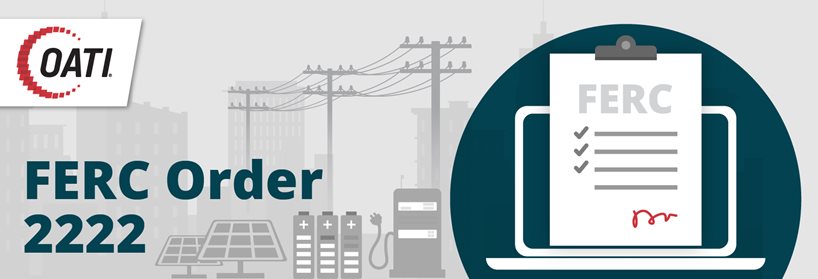Home » Blog » Grid Modernization » When is a Distributed Energy Resource Management System Necessary?
When is a Distributed Energy Resource Management System Necessary?
The Department of Energy’s (DOE) Grid Modernization Initiative was launched to transform a 20th Century grid model of largely centralized generation and independently controlled loads to one of a seamlessly integrated grid with both centralized and distributed generation, as well as participatory, coordinated loads. This transformation is in part driven by a growing number of Distributed Energy Resources (DERs) connecting to the distribution infrastructure on the utility side of the meter (Front-of-the-Meter or FTM) and/or on the customer side of the meter (Behind-the-Meter-or BTM).
Thus, it is easy to conclude that the proliferation of DERs is a sustainable trend. As DERs continue to roll out in your service territories, the question becomes not if a Distributed Energy Resource Management System (DERMS) is necessary, but when.
A DERMS is a distribution grid software platform and related communication technology that is meant to monitor (in near real time), control, forecast, schedule, and optimize DERs along with controllable loads. As an industry, we foresee that high levels of DER penetration on grids that were originally built for one-way power flow and utility-provided Volt-Amperes Reactive (VAR) control will create challenges related to DER, which will affect both flows and voltages. A DERMS provides advanced observability, command and control, and harmonization of DERs while considering and/or resolving grid conditions.
So, when is a DERMS needed? A single or few instances of small-capacity DER in your service territory may not require a DERMS solution. However, grid complexity increases as the number of DERs rise, which in turn increases the likelihood that a way to manage and optimize them will be needed.
There are a variety of solar energy use cases including FTM utility-scale solar photovoltaic (PV) systems arrays for passive power output and consumption, BTM end-consumer rooftop deployments, and community solar, to name just a few. When it comes to solar PV arrays, size and location use cases matter.
Generally speaking, FTM, passive solar PV arrays of just a few MW that have a direct connection to a substation do not drive much need for a DERMS. In this basic use case, aside from observability, a DERMS could be used to connect the PV output data to a utility back office and integrate the output with scheduling tools.
For utility scale FTM solar PV arrays that are located along the feeder, their location alone will very likely be a driver for a DERMS, due to impacts on feeder voltages and VARs. FTM solar PV arrays equipped with smart inverters can be used to support not only active, but also reactive power. Smart inverters can also be used to produce reactive power, even when the sun is not shining. Furthermore, a DERMS can help manage and mitigate reverse flow impacts.
Small or moderate deployments of end-consumer-based BTM solar energy, such as residential rooftop deployments, where the location of the solar PV system is literally “behind the meter” on the owner’s property, may be manageable for a utility without special tools. However, with moderate to higher penetrations of DERs the benefits of a DERMS increases.
Community solar is a trending use case. It provides an option for end-consumers to bypass BTM solar for a portion of a coordinated, utility-managed FTM PV solar array. A DERMS can be used to provide observability, capture and monitor the output, and apportion the related value to each customer, based on the utility program and/or in conjunction with a wholesale market program to capture and apportion the value of the energy/capacity of the solar generation in the market.
There are many types of DERs other than solar energy, e.g., EV charging stations, microgrids, energy storage, gas microturbines, wind, and traditional standby diesel generators. The value proposition for a DERMS increases as the number, variety, and use cases for DERs exacerbates over time, each having unique, small-scale power plant generation capabilities that impact the grid, both locally and system-wide. Solar and storage is a common pairing where a DERMS can be used to intelligently charge and discharge the storage facilities in concert with the variable solar generation units and the utility business objectives.

The management of distribution grids with increasingly higher levels of distributed energy resources is one of the central issues confronting distribution utilities. Energy industry experts, like OATI, can help utilities review their DER use cases and provide a roadmap to help determine when and how a DERMS adds value to grid operations, including the abilities to: provide situational awareness, account for and mitigate the impact of DER on grid reliability, and capture the economic values of DER that can encompass wholesale market opportunities.
About the Author:
Linda Stevens is Sr. Director of Sales for OATI’s Grid Modernization Solutions. She holds a Bachelor’s Degree in Organizational Management and Leadership from Concordia University in St. Paul, MN. Ms. Stevens has dedicated her career to the energy industry. She began in an Investor Owned Utility where she learned firsthand about utility operations. This experience transitioned to an energy industry software and technology sales career path. Through a network of direct OATI sales executives, key technology alliances, and an industry leading distribution channel, she drives the strategic sales initiatives for OATI’s grid modernization (or Smart Grid) portfolio, with an emphasis on solutions for cooperatives and municipals.
- November 30, 2016
